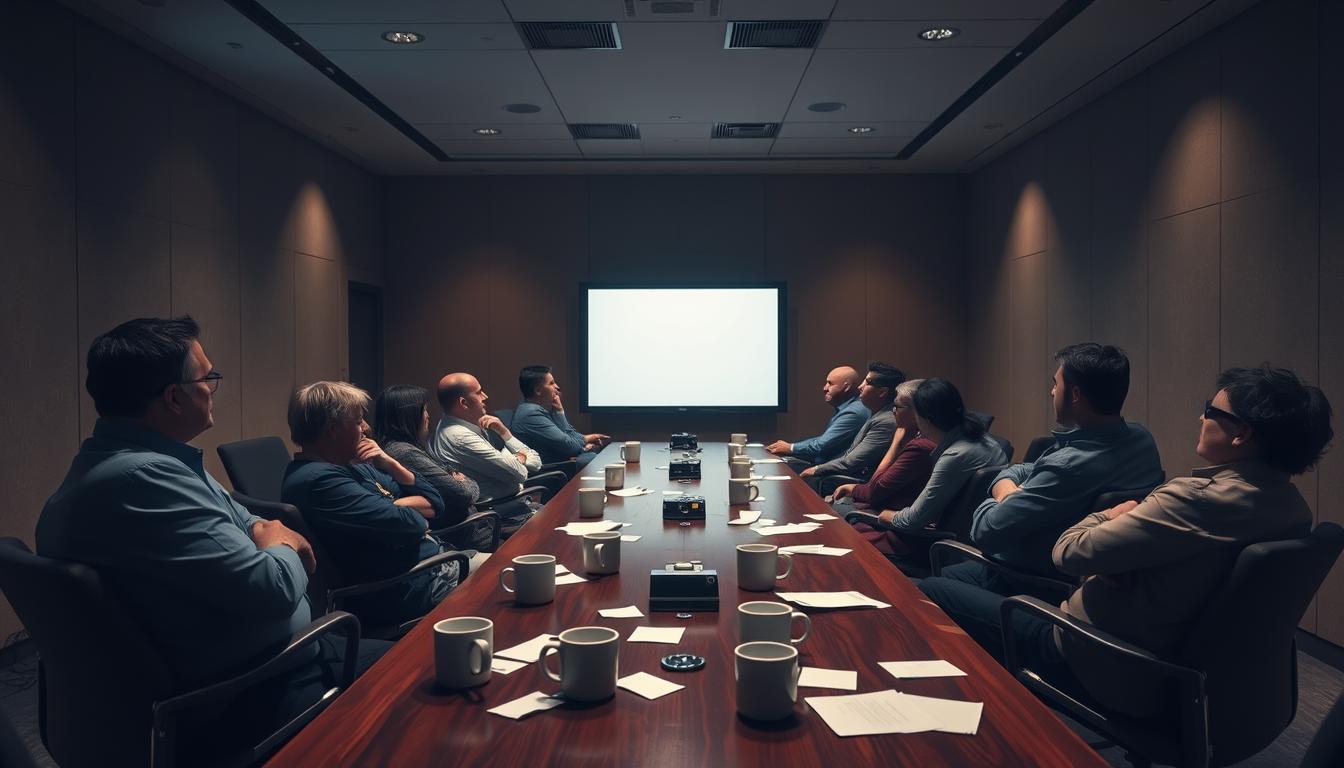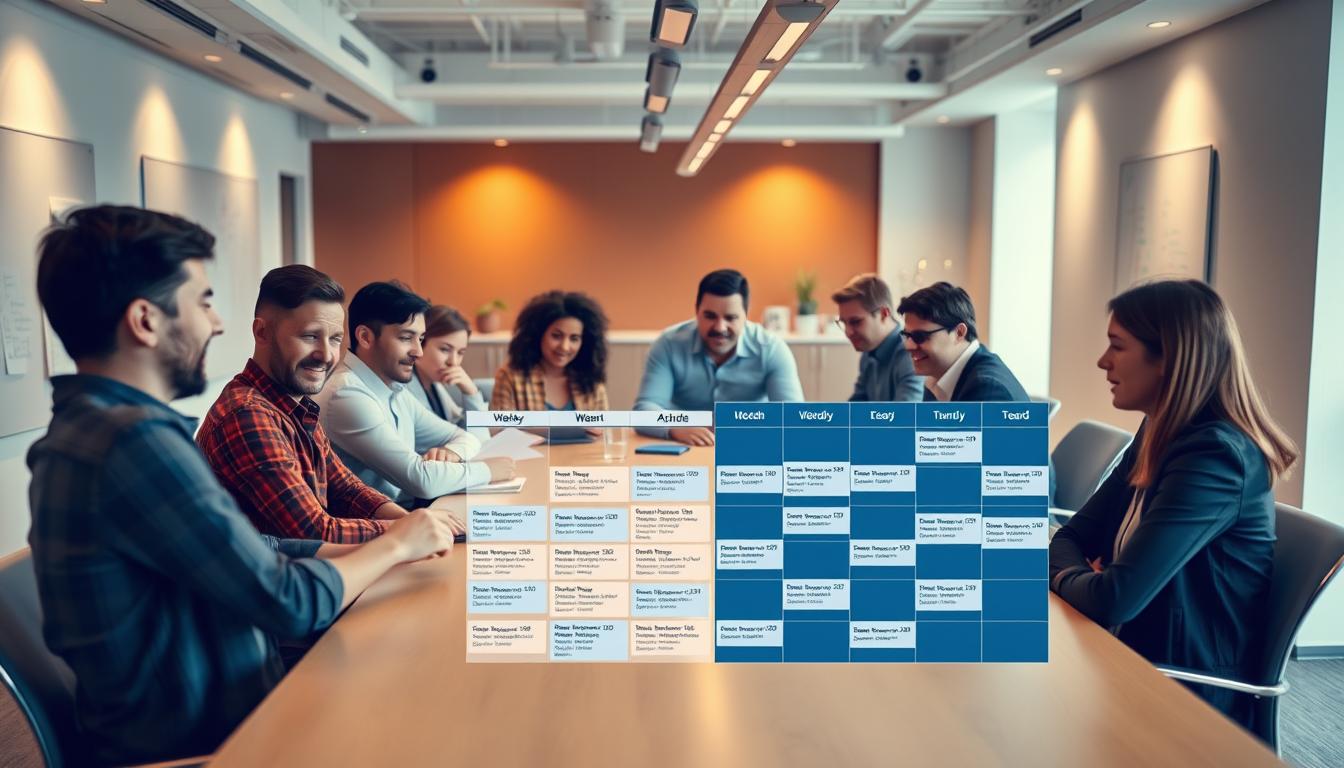In today’s fast-paced work world, dealing with a messy meeting schedule is tough. Moving to online chats has made it more crucial to organize meetings well. This makes them short and values everyone’s time. Good online meeting handling boosts teamwork and gets more done.
Fixing the mess in meetings can help teams work better. It clears the path for talks that really get to the point. This leads to results that matter.
Understanding the Importance of Streamlined Meeting Schedules
A good meeting schedule is key for a productive workplace. It helps with managing time well. It also cuts down on the annoyance often felt with bad meetings. Clear goals and respecting time lead to the perks of organized meetings.
Benefits of a Well-Organized Schedule
Well-planned meetings mean less distractions. Everyone focuses on what’s important. This makes teams more productive. When meetings are done right, staff feel their input matters. This boosts their commitment and happiness at work.
Impact on Productivity and Employee Morale
Meetings that don’t waste time make workers happier. Valuing everyone’s time creates a culture of teamwork. This not only ups productivity but also strengthens how well a team works together. It makes employees more driven and engaged.
Identifying Your Disorganized Meeting Schedule
Spotting signs of a messy meeting schedule is key to creating a productive work setting. Disorganized meetings usually show traits that block progress and teamwork. By dealing with these problems quickly, you can make your calendar efficient and aligned with your goals.
Common Characteristics of Disorganization
Many find their meeting schedules are messy. This often shows as meetings without clear goals, leading to endless talk with no real action. People tend to not pay attention or give little input. Usually, these meetings start late and waste time because there’s no plan. Inviting people who don’t need to be there only makes things more confusing and hurts the meeting’s focus.
Consequences of Ineffective Meeting Practices
Not fixing disorganized meetings leads to a cycle of bad meetings that upset everyone and waste time. These unproductive meetings lower team spirit. Without clear direction, people lose interest and work less effectively. In the long run, this hurts teamwork and weakens the company’s success.
Setting Objectives for Your Meetings
It’s vital to set clear objectives for meetings to succeed. By identifying the goals, leaders can steer the conversation, boost productivity, and keep everyone on the same track. This way, meetings become more collaborative and effective.
Defining Clear Goals
Having specific objectives prepares participants better. If everyone knows the goals, the discussion stays on point and is fruitful. Without clear objectives, meetings can stray, leading to lost time and frustration.
Ensuring All Participants Are On the Same Page
Getting everyone aligned is crucial for engagement and results. Sharing the meeting goals beforehand makes attendees more committed to the meeting’s success. This forward-thinking method promotes open conversation and sparks innovation.
Strategies to Tame a Disorganized Meeting Schedule
To take back control of messy meeting schedules, good time management is key. Use structured methods and the right tools to make meetings more effective and less disruptive.
Implementing Time Management Techniques
Using time management strategies, like blocking time for meetings, helps everyone plan better. This ensures important tasks get done with fewer interruptions. Preparing well also helps by setting clear goals, leading to more productive meetings.
Utilizing Technology for Scheduling
Modern scheduling tools can change how you organize meetings. Tools like Calendly, Google Calendar, or Microsoft Outlook make things easier. They send automated reminders and have scheduling options that cut down unnecessary communication, making everything run smoother for people involved.
Preparing Effectively for Each Virtual Meeting
For virtual meetings to go well, preparing right is key. This means making an agenda and gathering what you need ahead of time. These steps make sure everyone knows what to do and comes ready to take part.
Creating and Distributing Agendas
A well-planned agenda is crucial for guiding the meeting. It lists what will be discussed, how long each part should take, and what we aim to achieve. By giving out the agenda before the meeting, everyone can come prepared. This really improves what everyone brings to the discussion.
Here are a few tips to make your agendas better:
- Make each agenda item clear with definite goals.
- Set aside specific times for each topic to stay on schedule.
- Send out the agenda at least a day early to give everyone time to prepare.
Gathering Necessary Materials in Advance
Gathering the right materials before the meeting is crucial. You need to bring all documents, data, and other resources that will be needed. This ensures everyone can join in the talks effectively. Here are some important steps to follow:
- Figure out what materials you need for every agenda point.
- Share these documents early using platforms that make access simple.
- Check that all your tech works with the meeting software.
Facilitating Engaging Virtual Meetings
Virtual meetings are key for keeping productivity and morale high today. Using active methods is important for everyone to take part meaningfully.
Promoting Interactive Elements
To make your online meetings more engaging, add interactive parts like:
- Live polls to get quick thoughts on the topics
- Breakout chats for smaller groups to talk more easily
- Brainstorming sessions to come up with new ideas together
These parts keep everyone involved and help create a lively setting. This setting helps build a community feeling among team members.
Encouraging Feedback for Continuous Improvement
Getting feedback is critical for making meetings better over time. Allow ways for people to share their views after the meeting. Consider these steps:
- Send surveys to find out if people liked the meeting
- Use forms to get comments on the meeting’s content and how it was run
- Have quick talks to see what worked well and what didn’t
This feedback makes future meetings better. It also makes sure everyone’s opinion is heard, leading to a stronger, more united work environment.
Overcoming the “Back-and-Forth” Scheduling Nightmare
Trying to manage meeting times often leads to a lot of back-and-forth. This wastes time and lowers our productivity. Using good scheduling tools can solve these problems, making it easier to plan meetings.
Using Scheduling Tools Effectively
SavvyCal and similar tools help us fight the chaos of scheduling. They let everyone see when others are free, in real-time. This cuts down on endless emails about when to meet. With these tools, planning meetings becomes less of a headache and more efficient.
Automating Meeting Confirmations and Reminders
It’s also important to automate meeting confirmations. Scheduling tools that send reminders help keep everyone informed about their meetings. This approach helps avoid last-minute cancellations and people forgetting to show up. By doing this, meetings are more organized and everyone stays on the same page.
Best Practices for Follow-Up After Meetings
Effective follow-up after meetings keeps the momentum going. It ensures everyone knows their duties. Using the right documentation practices helps remember the main discussion points, decisions, and tasks given. This approach makes sure everyone is accountable and boosts productivity.
Documenting Meeting Minutes and Action Items
Writing clear and concise meeting minutes is key. They should capture what was talked about, decisions made, and tasks assigned. Sharing these notes with all attendees helps everybody understand what is expected and the deadlines.
- Summarize key discussions in bullet points.
- Highlight decisions made during the meeting.
- List action items with assigned responsibilities and deadlines.
Ensuring Accountability for Follow-Up Actions
It’s important for someone to own each task for good follow-up. Checking in often can show how tasks are moving and help tackle any issues. Here are some tips:
- Schedule regular check-ins to discuss the progress of action items.
- Utilize project management tools to monitor task completion.
- Encourage open communication and feedback among team members.
Creating a Positive Meeting Culture in Your Organization
Creating a positive meeting culture is key for organizations that aim for success. It involves setting norms that guide how meetings are run. When everyone knows and agrees on these values, meetings turn into spaces for effective teamwork and discussion.
Establishing Norms and Expectations for Meetings
Setting clear rules for meetings helps everyone know what’s expected of them. Important points include:
- Starting meetings on time to respect everyone’s schedule
- Encouraging preparation to maximize productivity
- Allowing equitable participation to foster diverse perspectives
When the norms reflect everyone’s shared values, meeting culture improves. This leads to discussions that are more effective and productive.
Training Employees on Effective Meeting Practices
Training is vital for building a strong meeting culture. It provides the tools and knowledge for better etiquette and effectiveness in meetings. Training can cover:
- How to create and share impactful agendas
- Best practices for facilitating discussions
- Methods for documenting and following up on action items
By including training in your organization’s strategy, you ensure that all team members can add value to meetings.

Conclusion
In our fast-moving business world, making meetings efficient is super important. Messy schedules can waste time and hurt work spirit. Using the tips from this article, companies can turn messy meetings into productive ones.
It’s crucial to have clear goals and use the best tech for the job. As businesses grow, updating how meetings work is a must. This keeps up with how we communicate and work together, making sure everyone feels valued and responsible.
Taking the time to improve meeting practices pays off for everyone at the company. Good strategies boost the way we work and our office vibe. Try these ideas and see how they make things better at your work.



